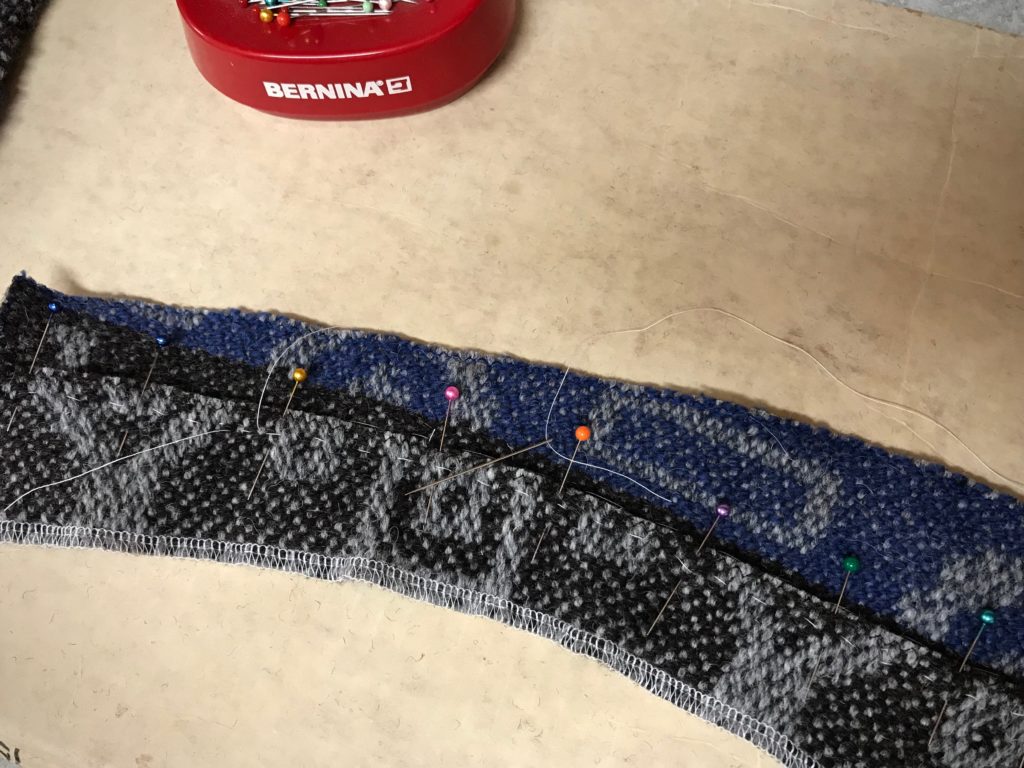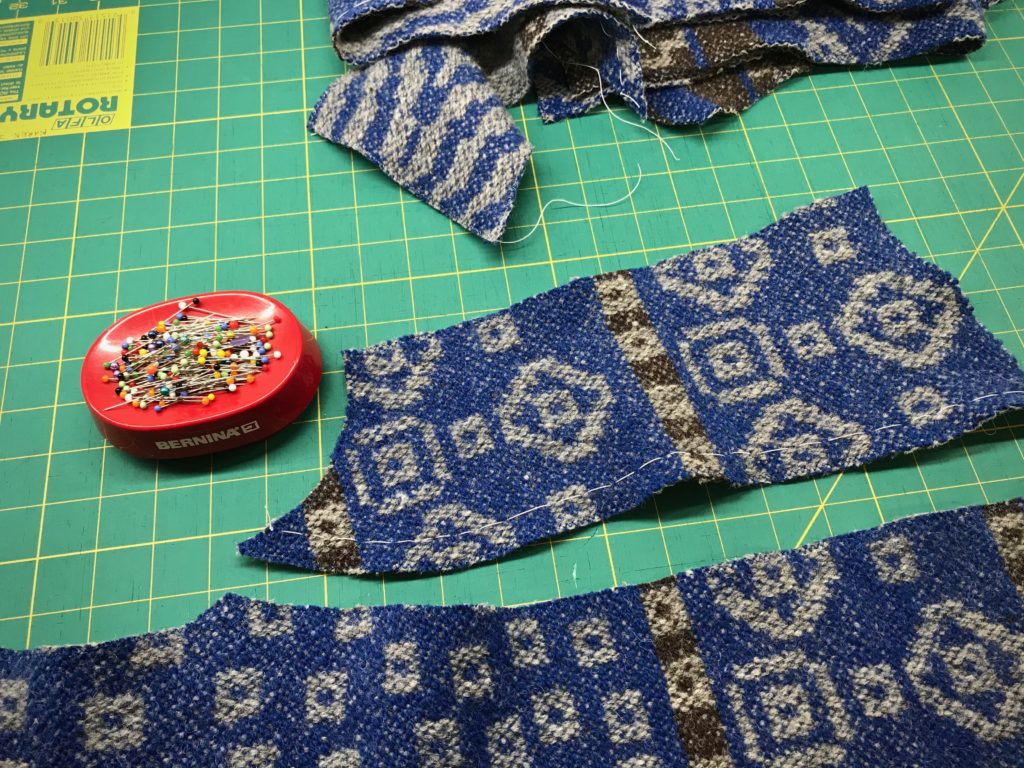I warped the drawloom with gray 6/2 Tuna wool several months ago with the goal to make fabric for a reversible vest. The beautiful drawloom fabric turned into dreamy garment-worthy fabric after washing! (See Process Review: Drawloom Jewels)

And then I hit two huge hurdles.
Hurdle 1. Fit.
In order to cut into handwoven drawloom fabric, I need assurance that the end result will fit me. My sewing assistant helped me refine a commercial pattern.

After umpteen muslins and two or three mock-ups, I finally got the fit I was after. Confidence to cut!
Hurdle 2. Garment Construction Uncertainties.
Do some detail studies, my dear friend Elisabeth said to me. Her advice got me over the insecurity hurdle. A detail study is making a small sample to test a hypothesis or answer a question. I made a list of everything I wanted to know about constructing a vest from this type of handwoven wool fabric. And then, using some of the extra fabric from the sampling at the beginning of the warp, I did a detail study for each point on the list. Twelve detail studies in all.
(If you are interested in seeing my complete list of 12 detail studies for this project, click HERE to send me an email and ask for my “Detail studies”.)
Here are a few examples of my findings:
- Zigzag before or after cutting? // Zigzag before cutting, stitch width 3, stitch length 2 1/2
- Lapped seams? 3/8”, 1/2”, 5/8”? // Yes, lapped seams, overlap 1/2”, stitch basted line to guide placement
- Neck and armhole curves – staystitch with hand running stitches or machine stitching? 1 row or 2? // Hand running stitches, 2 rows

From the results of the detail studies I was able to compile a step-by-step garment construction plan. Confidence to sew!
Follow my process pictures of the garment construction to see the results:














May you find ways to leap over your hurdles.
Love,
Karen

Oh My! It turned out so well, though there was never any doubt in my mind! You must be so proud! I love how it looks on you. You are so inspiring!
Hi Geri, Thank you! This was one big learning experience for me.
Thanks for following along,
Karen
This is so stunning! As a beginner weaver, I hope to aspire to constructing woven garments someday!
Hi Tena, Constructing woven garments is something I have wanted to do for a long time. I’m glad to see you’re on the same quest!
Happy weaving,
Karen
I’ve been peeking at your website for years and have always found it so inspiring! Your creativity seems to be boundless! Your vest turned out beautifully! Thanks for so generously sharing your process in making your projects. I have found so many tips and helpful instruction from you about weaving and also life!
Marianne, Thank you for your heart-warming comment. It is my delight that someone like you comes along on this journey with me!
Thank you, thank you,
Karen
An absolutely beautiful result, Karen! And you have taken such care in each step along the way.
Blessings to you!
Hi Bev! It’s taking time to mind the details that brings about good results, as you know very well in your beautiful quilting projects.
Blessings to you, too!
Karen
It’s gorgeous, Karen! I am in awe of your patience, as well as your weaving and sewing skills.
Hi Betsy, It’s this gorgeous loom of yours that made it possible. I have the pleasure of sitting at the drawloom and making things from it. Yes, it did take an extra degree of patience to push this project to completion.
Thank you, friend,
Karen
I really need to get my Tuna yarn drawloom fabric made into a vest. Thanks for showing us yours. I started to think that I needed to make it a pullover to avoid all the hand stitching in the front. Hmmm. I am still thinking.
Joanne
Hi Joanne, I’m eager to see what you do with your beautiful Tuna yarn drawloom fabric! The hand stitching was very pleasant to do. I enjoyed it. I’d sure like to see a picture of your vest when you complete it.
Happy thinking,
Karen
Awesome. Love the pattern and colors.
Question. Was the back done in 1 piece or 2, if 2 could it have been one piece or to fit properly did it have to have a center seam?
Hi LJ, Thank you!
Great question. I intended the back to be one piece, and the sides to each be a single piece. But I was able to get a better fit by putting in a back seam, and making a seam down the sides. This was part of my fit dilemma. I wove the fabric with those single pieces in mind, but the outcome of the mock-ups was just too boxy for my petite frame. Someone with more fitting experience may be able to make the single back piece work.
Thanks for asking,
Karen
I can’t decide which side I like best! Both look great on you, Karen.
I am going to download your steps because I hope to get the courage to try sewing with my handwoven fabric someday soon. As I am just a beginning level sewer, I was surprised at all the consideration needed; such as the width of seams, length of stitches, etc.. Thank you for sharing your experiences.
Oh, and I recently purchased the book you recommended to me, Karen. The Big Book of Weaving by Laila Lundell. My plan is to do as you recommended and follow through from the beginning.
Looking forward to your future posts.
Hi Annie, I’ve always been partial to reversible garments. It’s fun to have two garments in one!
Happy weaving journey to you!
Karen
You are truly amazing and so capable! How timely to talk about embracing your hurdles! Can’t imagine KI would have hurdles! You and your vest look lovely! There is a woman sheep farmer, weaver environmentalist in CA who has raised the sheep and wove the fiber into yardage and sold the yardage on a limited basis. I bought a small amount and have been thinking about what to make with it. It’s a beautiful white, unused fabric! Your experience and blog posting here will be immensely useful for my sewing project. Thanks!
Hi Shari, Me and hurdles? oh yes, more than you’ll ever know!
Your undyed wool yardage sounds lovely! I know you’ll make it into something memorable. I’d love to see pictures when you’re done.
Thanks for all your kind words,
Karen
The above posting has a typo. The yardage is natural, undyed yardage. I think the weave structure is twill.
Beautiful work, Karen! I wish you were here to model it for us at WOW. We miss you!
Hi sweet D’Anne, I miss you and all the WOW group, too!
Thanks so much,
Karen
Wow! Beautiful!
Hi Mary, Thank you so very much!
Karen
Gorgeous fabric! Thanks for sharing your process and how you worked through it.
Hi Allison, It’s a treat to get to share my process with you.
Thank you!
Karen
Dear Karen, what a find to have found you in cyber space! So enjoy your website and your talents and your sharing and blogs etc. Wow, your work is an inspiration and the vest is beautiful. What a wonderful experience it must be to have totally created this wearable garment from simple thread to weaving to designing and cutting and sewing. Amazing!! God bless you and so glad I “tuned” in. Best regards, Nancy
Hi Nancy, You have touched my heart. You so perfectly captured my sentiments! – It is extremely satisfying to start with thread and design actual fabric, and end up with a wearable garment. It feels like a dream come true.
God bless you,
Karen
Your vest is beautiful and looks so lovely on you! Thank you for your generosity in sharing your project experience with us. Your blog is a treasure!
Hi Kristin, Your kind words are a treasure to me. I’m so happy to have like-minded friends to share these things with.
Happy weaving,
Karen
Lovely work, it’s nice to see someone doing woven garments rather than tea towels or scarves; much as I love those things I started weaving in order to make my own fabric for sewing.
Hi Rachelle, How fascinating that you started weaving so you could make garment fabric. It’s something I’ve been interested in for quite a while, too. It’s tricky to get all those skills to work together, but it’s fun to keep learning.
Thanks for chiming in!
Karen
Karen,
You are such a detail person.
BEAUTIFUL vest!!!!
Perfect to go over a sequined gown or jeans.
I hope you wear it often.
Nanette
Hi Nannette, You’re right, I do enjoy paying attention to detail.
I don’t have a sequined gown, so mostly it will go with jeans or a simple skirt.
Thank you so much!
Karen
Very interesting to see this view. I recognize many of the responders names. In awe as I only weave on an 8 shaft Bergman. I have woven on others drawlooms though! So am familiar with the process. At least four projects or more. I can enumerate many including one that is in one magazine.
Hi Ladella, Thanks for sharing your thoughts. Drawlooms are very interesting looms to weave on. There are projects in some Väv Magazine issues that I would like to try.
All the best,
Karen